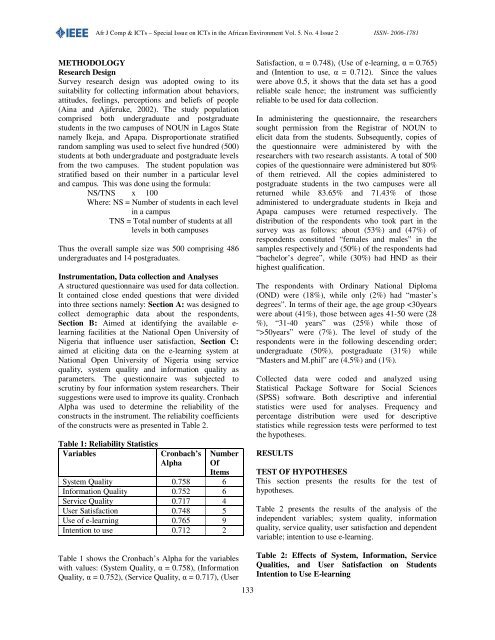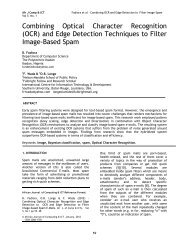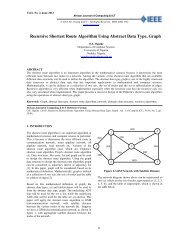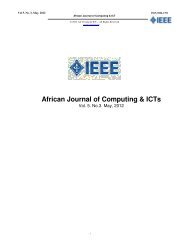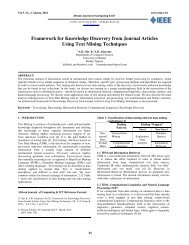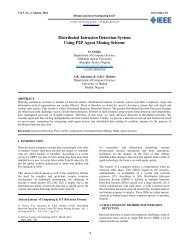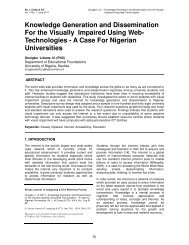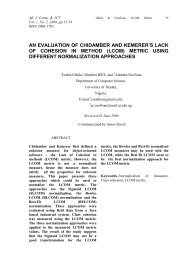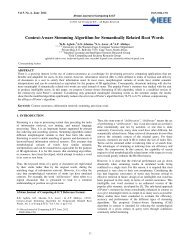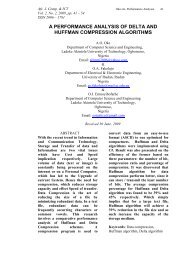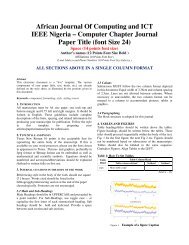Satisfaction With an E-Learning System - IEEE Afr J Comp & ICTs
Satisfaction With an E-Learning System - IEEE Afr J Comp & ICTs
Satisfaction With an E-Learning System - IEEE Afr J Comp & ICTs
You also want an ePaper? Increase the reach of your titles
YUMPU automatically turns print PDFs into web optimized ePapers that Google loves.
<strong>Afr</strong> J <strong>Comp</strong> & <strong>ICTs</strong> – Special Issue on <strong>ICTs</strong> in the <strong>Afr</strong>ic<strong>an</strong> Environment Vol. 5. No. 4 Issue 2 ISSN- 2006-1781<br />
METHODOLOGY<br />
Research Design<br />
Survey research design was adopted owing to its<br />
suitability for collecting information about behaviors,<br />
attitudes, feelings, perceptions <strong>an</strong>d beliefs of people<br />
(Aina <strong>an</strong>d Ajiferuke, 2002). The study population<br />
comprised both undergraduate <strong>an</strong>d postgraduate<br />
students in the two campuses of NOUN in Lagos State<br />
namely Ikeja, <strong>an</strong>d Apapa. Disproportionate stratified<br />
r<strong>an</strong>dom sampling was used to select five hundred (500)<br />
students at both undergraduate <strong>an</strong>d postgraduate levels<br />
from the two campuses. The student population was<br />
stratified based on their number in a particular level<br />
<strong>an</strong>d campus. This was done using the formula:<br />
NS/TNS x 100<br />
Where: NS = Number of students in each level<br />
in a campus<br />
TNS = Total number of students at all<br />
levels in both campuses<br />
Thus the overall sample size was 500 comprising 486<br />
undergraduates <strong>an</strong>d 14 postgraduates.<br />
Instrumentation, Data collection <strong>an</strong>d Analyses<br />
A structured questionnaire was used for data collection.<br />
It contained close ended questions that were divided<br />
into three sections namely: Section A: was designed to<br />
collect demographic data about the respondents,<br />
Section B: Aimed at identifying the available e-<br />
learning facilities at the National Open University of<br />
Nigeria that influence user satisfaction, Section C:<br />
aimed at eliciting data on the e-learning system at<br />
National Open University of Nigeria using service<br />
quality, system quality <strong>an</strong>d information quality as<br />
parameters. The questionnaire was subjected to<br />
scrutiny by four information system researchers. Their<br />
suggestions were used to improve its quality. Cronbach<br />
Alpha was used to determine the reliability of the<br />
constructs in the instrument. The reliability coefficients<br />
of the constructs were as presented in Table 2.<br />
Table 1: Reliability Statistics<br />
Variables<br />
Cronbach’s<br />
Alpha<br />
Number<br />
Of<br />
Items<br />
<strong>System</strong> Quality 0.758 6<br />
Information Quality 0.752 6<br />
Service Quality 0.717 4<br />
User <strong>Satisfaction</strong> 0.748 5<br />
Use of e-learning 0.765 9<br />
Intention to use 0.712 2<br />
<strong>Satisfaction</strong>, α = 0.748), (Use of e-learning, α = 0.765)<br />
<strong>an</strong>d (Intention to use, α = 0.712). Since the values<br />
were above 0.5, it shows that the data set has a good<br />
reliable scale hence; the instrument was sufficiently<br />
reliable to be used for data collection.<br />
In administering the questionnaire, the researchers<br />
sought permission from the Registrar of NOUN to<br />
elicit data from the students. Subsequently, copies of<br />
the questionnaire were administered by with the<br />
researchers with two research assist<strong>an</strong>ts. A total of 500<br />
copies of the questionnaire were administered but 80%<br />
of them retrieved. All the copies administered to<br />
postgraduate students in the two campuses were all<br />
returned while 83.65% <strong>an</strong>d 71.43% of those<br />
administered to undergraduate students in Ikeja <strong>an</strong>d<br />
Apapa campuses were returned respectively. The<br />
distribution of the respondents who took part in the<br />
survey was as follows: about (53%) <strong>an</strong>d (47%) of<br />
respondents constituted “females <strong>an</strong>d males” in the<br />
samples respectively <strong>an</strong>d (50%) of the respondents had<br />
“bachelor’s degree”, while (30%) had HND as their<br />
highest qualification.<br />
The respondents with Ordinary National Diploma<br />
(OND) were (18%), while only (2%) had “master’s<br />
degrees”. In terms of their age, the age group 50years” were (7%). The level of study of the<br />
respondents were in the following descending order;<br />
undergraduate (50%), postgraduate (31%) while<br />
“Masters <strong>an</strong>d M.phil” are (4.5%) <strong>an</strong>d (1%).<br />
Collected data were coded <strong>an</strong>d <strong>an</strong>alyzed using<br />
Statistical Package Software for Social Sciences<br />
(SPSS) software. Both descriptive <strong>an</strong>d inferential<br />
statistics were used for <strong>an</strong>alyses. Frequency <strong>an</strong>d<br />
percentage distribution were used for descriptive<br />
statistics while regression tests were performed to test<br />
the hypotheses.<br />
RESULTS<br />
TEST OF HYPOTHESES<br />
This section presents the results for the test of<br />
hypotheses.<br />
Table 2 presents the results of the <strong>an</strong>alysis of the<br />
independent variables; system quality, information<br />
quality, service quality, user satisfaction <strong>an</strong>d dependent<br />
variable; intention to use e-learning.<br />
Table 1 shows the Cronbach’s Alpha for the variables<br />
with values: (<strong>System</strong> Quality, α = 0.758), (Information<br />
Quality, α = 0.752), (Service Quality, α = 0.717), (User<br />
133<br />
Table 2: Effects of <strong>System</strong>, Information, Service<br />
Qualities, <strong>an</strong>d User <strong>Satisfaction</strong> on Students<br />
Intention to Use E-learning


